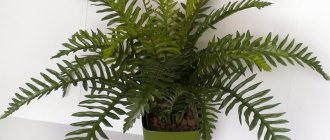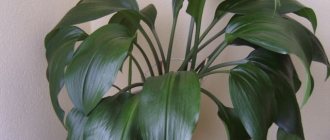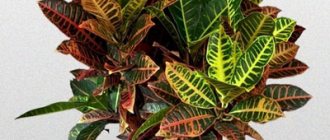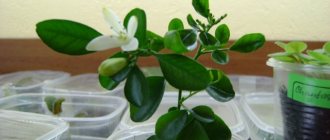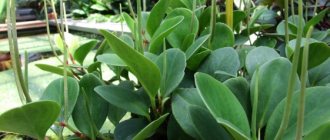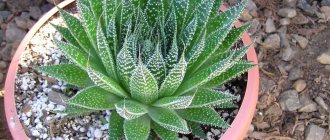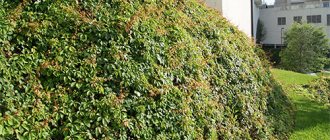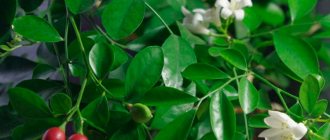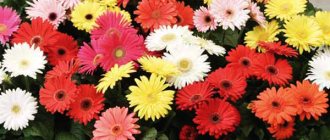The most popular of all varieties of codiaum, “Petra,” has become something of a legend. Thick light veins make the green-brown whole leaves even brighter. And the branchiness inherent in the plant pleasantly distinguishes this croton from other powerful and tall varieties. A lush and bright, watercolor-autumn palette is characteristic of all crotons. But few decorative forms combine it so successfully with bright and rich green. At the same time, “Petra” tolerates some mistakes in care more easily than other varieties of codiaums. Although the plant is more warm and light-loving.
Codium "Petra" is the most reliable among crotons
We take care according to all the rules
Codiaum is a capricious plant; when grown at home, it will require constant, proper care.
The fastidious green resident needs to be planted in nutritious soil. An excellent start is the application of peat and complex fertilizer. Stagnation of water can destroy the root system and lead to the death of the plant.
An important condition for care is wiping off dust on leaves and window glass. It blocks the way to the sun's rays.
Drafts should be avoided when choosing a location. One might well think that Codiaum, being a tropical plant, cannot exist in our climate and air temperature. As it turned out, this is not at all the case.
Air humidity
Being a tropical plant, Codiaum is overly picky about air humidity. When growing such a green friend in the house, it is difficult to maintain the humidity required for it (60-70%). Also, the plant should be sprayed daily, the leaves should be wiped regularly, and sometimes you can put it in the shower.
The water for procedures should be warm (20-25 degrees). In winter, heating batteries dry out the air greatly, which means humidification should be done even more often. The flower pot can be placed on a tray with wet pebbles; it is recommended to place a container of water nearby.
Codiaeum varigatum (varigatum) Petra: home care
Codiaeum varigatum (varigatum) Petra
The Codiaum Petra flower is considered a symbol of the hearth. They say it protects from the evil eye. In wildlife, it is widespread in tropical countries: Indonesia, India, Australia, the jungles of Malaysia. Shrubs grow up to 2.5 meters, trees - up to 6 meters. At home it is small, only 50-70 cm. The name codiaum comes from the Greek language, which means “head”. Indeed, it resembles a thick, as if tousled, cap of hair. The leaves of codiaum variegated are leathery, large, up to 30 cm long, multi-colored. The veins on the greenish background are clearly expressed; they can be yellow, red, burgundy, making the flower bright and variegated, like a forest touched by early autumn withering. The leaves of codiaum species can be sharp, like tongues, oval, blade-shaped, or simply elongated. Codiaum Petra rarely blooms, the appearance of the inflorescences is inconspicuous and small.
Belongs to the species Codium, the Euphorbia family. The juice, like all milkweeds, is poisonous. Be careful.
Several varieties of codiaum are known: Vilma, Batik, Mammy, Gold, Excellent, Sunny Star. Codium (variegated) varigatum is commonly called Croton Petra. Probably they are simplifying it because of the complex, difficult to pronounce name. Yes, and it’s hard to remember. From the point of view of biological science, this is wrong. Croton and codiaum variegata are completely different types of plants. Croton includes 1200 species, codiaum - only 17.
Confusion does not significantly affect the care and maintenance of plants, since the conditions of existence in nature for the species are almost the same.
At first glance, it seems that a plant with such large, healthy leaves is unpretentious, but opinions are deceptive. Codium varigatum is capricious and requires careful care. It does not tolerate drafts, and at the slightest breeze it immediately reacts to discomfort by dropping its leaves. Codiaum Petra reacts poorly to dry air, dust, direct sunlight, and cold. They are fed with organic matter and complex fertilizers all year round: in winter - once a month, in the off-season - once a week.
Watering. The tropical child loves warmth and moisture. It is advisable to spray the leaves with settled water at room temperature every day, wash them at least twice a week, put them in the shower once a month, and place them under running water.
Lighting. Prefers bright, diffused light; direct sunlight is harmful to it. It is better to place the flower near the windows on the east and west sides. In the northern ones, it simply does not have enough light, then the leaves will eventually lose their unusual color.
Temperature. Does not tolerate changes. In summer it feels good at 20 - 24 degrees, in winter - not lower than 18 degrees Celsius. In autumn and winter, it is better to place a flower pot next to the radiator.
Replanting and pruning. Needs annual replanting. The pot is chosen to be tight, slightly wider than the previous one. The soil is prepared in advance. Mix sand, peat, humus, soil with leaves and turf in equal proportions. The bottom is covered with drainage (pebbles, expanded clay, fragments of tiles, bricks). They clean the roots from the old soil, place them in a pot, cover them with new soil and press them down on the sides. Be sure to water abundantly. In the spring, when the variegated codiaum begins to grow, the side shoots are partially removed. If there are no branches, pinch the top. Codiaeum pictum propagates well by cuttings. For this purpose, cut stems and tops are used.
Codiaeum varigatum (varigatum) Petra can be bought in stores in St. Petersburg. Prices and specifications are indicated in the catalogue.
Resuscitation of damaged miltonia without roots
One of the most delicate parts of this plant is the root system, which can often rot, be injured, and die. But do not despair, since experienced flower growers have known successful results in resuscitating refined miltonia in the absence of a rhizome. This procedure can last from two months to a year.
The initial stage of this process involves soaking the damaged parts daily. This water “bath” should last from 3 to 5 hours at a temperature of about 22ºC. To obtain better and faster results, periodically, but not more than once every 2-3 weeks, enrich the water with growth stimulants.
Reanimation of damaged miltonia without roots will be completed as soon as the length of the young root shoots is more than 5 cm. This is a signal that the plant is ready to develop in the substrate under its usual conditions. And now the main task is to prevent the delicate orchid from dying and withering again.
Appearance and general description
So, to reassure you that your houseplant is most likely not a croton, let's start with what it should look like.
This wild plant belongs to the Euphorbiaceae family. In the wild, it is represented by trees, shrubs or ordinary herbaceous plants. Visually, the plant appears grayish due to the fact that the leaves and flowers are covered with hairs or scales.
The leaves are entire and quite large. One of the features of the plant is the unusual color of the foliage: the leaves can be green, light green or red-brown, and also have many veins that stand out against the background of the leaf plate.
Now let's move on to the description of colors. How does croton bloom? Croton flowering is not uncommon. This plant blooms with monoecious flowers, which, as a rule, do not grow singly, but form complex inflorescences.
The size and appearance of croton flowers depend on the specific type of this plant - as already mentioned, it is represented by trees, shrubs, and simply herbaceous plants.
There are about 450 varieties of this flower, and croton can also be poisonous. However, there are also many specimens that are absolutely harmless to humans, and in some cases it is even used in medicine, using it in the manufacture of medicine. So, for example, one of the most famous varieties of this flower, called Croton tiglium, is widely used to obtain oil, which has a laxative effect. Another type of this plant, elutheria, has more than one medicinal property, so it is used in the treatment of bronchitis, stomach and skin diseases.
The plant is considered to be quite finicky, so it will not be easy to maintain. Moreover, ignoring any maintenance conditions can cost the flower its health. However, due to its attractive appearance, as well as a lot of useful qualities that are used in medicine, this plant has gained great popularity. Although many still confuse it with codiaum and mistakenly classify it as a different species.
Why do miltonia leaves turn yellow and the plant does not bloom?
The inconsistency of the created living conditions with the requirements of a capricious orchid immediately has a negative impact on its general condition. The first signs of the disease appear in the yellowness and dryness of the leaf blades.
There are several reasons why miltonia leaves gradually turn yellow:
- Excess sun.
- Dry air.
- Highly concentrated fertilizers.
- Dense heavy soil.
- Moisture has entered the leaf axils.
By eliminating these causes, you can easily get rid of the phenomenon when Miltonia gradually turns yellow
And then the flower will thank you for your attention and care with its beauty and amazing aroma.
Among the dangerous insects that cause harm to the plant and are the reason why the orchid does not bloom, there are:
- Shield.
- Whitefly.
- Thrips.
Favorable conditions for their appearance: dry air, hot temperature. As a treatment, it is better to use a concentrated soap solution and insecticides.
We can confidently say that pests and diseases arise only with improper care.
Codiaum propagation
Codiaum is propagated by apical cuttings, air layering, and seeds.
Propagation of variegated codiaum by cuttings
Cuttings 9-10 cm long (preferably with one bud and two leaves) are cut from well-ripened lignified shoots. The top cut is made at a right angle and sprinkled with finely ground charcoal. Codium cuttings are placed in warm water with the addition of charcoal for a while to wash out the milky sap secreted by the plant. Then they are dried, and to improve rooting, the lower part is treated with growth stimulants - phytohormones. To reduce moisture evaporation, the leaves are tied with a tube. Cuttings of variegated codiaum can be planted in flower pots or placed in cups of water, but it is better to germinate them in a mini-greenhouse, in which you need to maintain an optimal soil temperature of 30C and air temperature of 25C.
In a small (up to 12 cm in diameter) pot you can place 2-3 codiaum cuttings. To do this, make indentations in the substrate with an ordinary pencil into which prepared cuttings are inserted. The soil at the base is lightly compacted with the same pencil. A mixture of peat or sphagnum with fine sand is used as soil. The substrate is constantly kept moist. The pots are covered with plastic bags or glass jars and placed in a warm place, for example, a windowsill, which is heated by a heating device.
Codiaum cuttings planted in pots or greenhouses must be sprayed daily. After a month and a half, rooted cuttings can be transplanted into individual containers.
Reproduction of variegated codiaum by air layering
Reproduction by air layering is carried out when the trunk and branches of the codiaum are very bare. Summer is the best time to carry out this procedure. On the lignified stem, 15 cm from the top, make a circular incision 1 cm wide. At this point, the codiaum layer will begin to form its own roots. The cut must be treated with a rooting stimulator (heteroauxin, root) and wrapped in wet peat or sphagnum, with polyethylene on top. Keep the substrate moist for 1 or 1.5 months until roots appear. When the roots reach 5 cm, the cuttings are cut off and transplanted into an individual container, initially covered with a bag or jar.
Air layering can be obtained by bending a lignified shoot of codiaum to the soil and attaching it with a pin in the place where you want to get roots, sprinkle soil on top. When young leaves appear, the cuttings are separated from the mother branch and transplanted into a new pot.
Propagation of variegated codiaum by seeds
Propagation by seeds is rarely used by flower growers, since it is difficult to carry out under indoor conditions, although it is possible. To do this, codiaum seeds are soaked in phytohormones and sown in a mini-greenhouse without embedding them in the substrate, simply pressing lightly with your hand. To maintain the required humidity, the seeds are covered with film or glass. The first shoots of codiaum appear in a month.
Transplanting a plant
If you create normal conditions during the growing process and proper care, Codiaum can reach considerable heights. This will require annual replanting into larger pots.
Adult tropical beauties do not require frequent relocation; this action should be performed no more than every 2-3 years. If the roots are already rebelling from lack of space in the flowerpot, protruding to the surface, then in such a case their demands must be urgently satisfied and moved to a more spacious container.
Features of care
Despite the differences in varieties, Codium variegatum mix flowers in any case require the same growing and maintenance conditions. This simplifies the task for gardeners planning to plant a plant on their windowsill, since they do not need to carefully study whether the purchased plant belongs to a particular variety.
Lighting
The color saturation of codiaum leaves depends on the intensity of illumination. It is best to place it on a south window
Direct sunlight will not harm the plant, but it is important to prevent its leaves from coming into contact with the heated glass
In winter, the plant may require an artificial increase in daylight hours using special phytolamps. With a lack of light, the leaves of the flower stretch, turn pale and fall off.
Air humidity
Codium is a capricious flower. It loves air saturated with moisture and is sensitive to rising room temperatures. That is why in the hot season and winter, when you turn on the heating system, you need to often spray the leaves of the flower and give it a warm shower.
Watering
You should also pay attention to the watering regime. Too dry soil or stagnant water will lead to the death of the flower.
You need to water the codiaum with soft warm water (a couple of degrees above the room temperature) as the substrate dries. The soil should be moist, but not wet.
You can use rainwater in summer and melted snow in winter. Hard water will cause spots on the leaves and drying out. Cold water can cause plant roots to rot.
The soil
For growing and caring for codiaum, a ready-made mixture for decorative foliage plants is suitable. To prepare the mixture yourself, you need to take equal parts of leaf and turf soil, peat and coarse sand.
The soil for this flower should be well-drained, and in some cases perlite or vermiculite can be used as drainage.
Fertilizers
Standard fertilizers for deciduous ornamental plants are well suited as fertilizer. They should be used during the period of active growth of codiaum, a couple of times every 7 days.
During the dormant period, that is, in winter, there is no need to use fertilizing.
Codiaum, which is not so easy to care for at home, will delight you with its variegated color all year round. For the sake of such lush landscaping, it is worth trying to comply with lighting and watering regimes.
Advice: in the winter, when the heating is turned on in apartments and houses, the indoor air becomes dry. Experts advise purchasing an automatic air humidifier - it will benefit not only indoor plants, but also apartment residents.
Such plants will help add bright colors to a modern monochrome interior.
Health
One should not ignore the existence of pests and various diseases to which Codiaeum Petra is susceptible. Most often, problems for the plant are caused by attacks from scale insects and spider mites. You can get rid of them by washing with soapy water; a more effective method is treating with fungicides.
It is best to immediately block the path of pests. This is not difficult to do; you need to constantly carefully inspect the bush and promptly remove harmful invaders. In addition, insects are afraid of the plant’s poisonous sap.
When growing Croton Petra you have to face some problems:
- When the tips of the leaves turn brown, the air in the room is dry and the soil is too dry.
- The dark brown color of the foliage is a consequence of low temperatures.
- Leaves fade - insufficient lighting.
If, when growing Codiaum Petra at home, you pay attention to it, maintain it according to all the rules, and provide constant care, it will be able to delight its owner with its variegated foliage for many years. There is just one caveat! You need to be very careful and not forget: the plant is poisonous, its milky sap can cause poisoning, skin burns, ulcers and other troubles. When working with it, remember to be careful!
Care
For a long time it was believed that codiaum was too thermophilic to be grown outside its natural range.
This plant is quite capricious and caring for it at home requires certain knowledge and skills.
Temperature
The plant is very demanding regarding temperature conditions.
The temperature should not only exceed + 17 degrees, but also be constant.
The child of the tropics reacts to the slightest draft by dropping leaves.
Watering
During the period of active growth, that is, in spring and summer, the plant needs to be watered regularly and abundantly. The soil should never dry out completely, otherwise its inhabitant simply will not survive.
However, flooding is also very dangerous for plants, as they can lead to rotting of the roots.
Sticking to the golden mean is quite difficult, so it is very important to have good drainage, which significantly facilitates the task
For irrigation you need soft and warm water. Cold water often causes leaves to drop.
The soil
Kodiem Petra needs nutritious soil rich in organic matter. Peat and complex fertilizer will be an excellent start. Good drainage is very important for the plant - it should make up at least a quarter of the total substrate.
Light mode
Since codiaum is of tropical origin, it needs good lighting throughout the year. Bright sunlight is beneficial for him even during the rest period.
But, of course, not straight, but diffused, and the plant should always be shaded from the midday sun.
In indoor conditions, Petra's croton rarely reaches its maximum size.
Nevertheless, it is difficult to call it small, and there is not always a window sill on which it could fit.
But this is not scary - if you place the plant at a distance of a meter from the window, it will have enough sunlight. East and west windows are best suited.
In winter, the codiaum should be moved to the brightest place in the room. If you can buy a special lamp, great. However, you need to make sure that there are no temperature changes in the new location - the plant cannot tolerate them.
It is very important to provide the Petra croton with decent lighting throughout the year. Otherwise, the leaves will lose their beautiful color and become simply green.
It's not enough to just choose the right place. You need to regularly wipe off dust on glass and leaves, as it can block up to 50% of sunlight.
Air humidity
Croton Petra always needs high air humidity.
During the period of active growth, the leaves should be regularly sprayed with warm water.
In winter, our apartments become especially dry due to heating devices and we need to humidify the air even more often.
At the same time, do not forget about the rest period - before each spraying, the soil must be covered with film.
Fertilizers
In spring and summer, fertilize the plant once every 2-3 weeks after watering or along with it. In winter, the frequency of feeding is reduced to once every 6-8 weeks. Nitrogen fertilizers are very important for the plant.
Transfer
In ideal conditions, Petra's garden croton grows up to 4 meters. Therefore, the young plant must be replanted annually into a larger pot (3 cm larger in diameter). It is recommended to leave the earth ball so as not to damage the roots.
An adult croton is replanted no more than 3 times a year.
Reproduction
Codium Petra reproduces well by seeds, leaves and cuttings. How to do it with cuttings:
- Cut off a woody cutting 15 cm long;
- Place in warm water with charcoal to wash off the milky juice;
- Dry the cuttings;
- Tie the leaves on the cuttings into tubes to reduce moisture evaporation;
- Plant the cuttings in the soil (peat, moss and sand);
- Cover with film;
- Ventilate and moisten the greenhouse with the cuttings daily.
Seeds and leaves are propagated in the same way. As soon as the roots appear, the young plant is transplanted to a permanent place of residence.
Bloom
Unlike the leaves, the flowers of Croton Petra are not particularly beautiful. They are small and inconspicuous.
It is recommended to cut off the peduncle immediately after it appears, so as not to deplete the plant.
Temperature
Codium is sensitive to temperature conditions and reacts especially poorly to its frequent fluctuations. For this reason, the following conditions must be created:
- In the cold months of the year, the thermometer shows +17-19 degrees.
- In the warm months of the year - about 20 degrees (a little more).
At any time, the main thing is to maintain consistency in the thermometer readings. If the leaves begin to curl and take on an unnatural dark brown color, it means the guest from the tropics is cold. You should pay attention to the temperature in the room. To prevent the leaves from being dropped, move the pot closer to the radiator.
Water and feed
It is difficult, but possible, to make a plant at home look as beautiful as in glossy photos.
The plant is native to the hot and humid tropics. Therefore, the leaves need to be sprayed daily and washed several times a week. During the active growth phase, watering should be plentiful, and moderate during the cold period.
It is important to keep the soil surface moist enough. Water for irrigation should be soft, settled and warm
Do not allow water to stagnate in the pan.
To prevent the soil from turning sour, you need to plant crotons in a tight pot. The roots, filling the space, absorb moisture better. Spray crotons with warm and settled water (at least 24 hours). Once a month, the plant needs to be watered abundantly in the shower.
Experienced flower growers, in order to maintain the required level of humidity, wrap the pot with wet moss or lower it into water on a special stand with expanded clay. The plant is fed with organic or mineral complexes throughout the year, in winter it is fed once a month, in spring and autumn - once a week.
Watering
Under natural conditions, the plant grew in places with a humid climate. When growing at home, it should be provided with abundant, but not excessive watering. It is necessary to take into account the fact that Codiaum reacts poorly to lime water. The water should be warm, settled, soft. Cold weather often causes the leaves to drop.
In spring and summer, when the plant is actively growing, it needs to be watered regularly and abundantly. Maintain the soil in a moderately moist state, watering only after the top layer has dried to a depth of 1 cm. It is advisable not to allow the soil to dry out, as this leads to the death of the pet.
In winter, water less frequently. Overwatering poses a great danger to the plant; at low temperatures it causes rotting of the root system. To avoid mistakes, it is recommended to take advantage of good drainage.
Care
Temperature
So, codiaum excelent! How to care? Let's start with the fact that a newcomer from the humid and hot wilds of Malaysia, the flower needs warmth, and feels best in the range of +21-25°C. It will withstand +18°C, but not lower - in cold soil its roots will quickly die.
For the winter, place it near the battery. Drafts are destructive for this sissy - as soon as it drops its leaves.
Light mode
This species truly loves the sun, especially its morning and evening rays - the more light, the brighter and more variegated its foliage; only in the hottest hours of summer days is openwork partial shade acceptable.
But you can leave the flower in the sun.
The main thing is not to spray it, otherwise the plant will get burns.
In winter, the codiaum should also receive as much light as possible.
Watering
In summer, codiaum craves moisture, so the soil in the pot should be kept moist (but not wet!). When watering, everything that is glass in the pan should be poured out immediately; excess moisture causes rotting of the roots.
You cannot take water for irrigation directly from the tap - it must stand for at least a day and warm up to at least room temperature. In winter, watering is reduced, but the earthen ball should not dry out.
Air humidity
Codiaum needs stagnant humidity, like in a tropical forest. You can create such a “bath” at home using a humidifier (especially in winter). Another convenient option is to place the flower on a “cushion” of wet pebbles.
Spray daily with soft warm water. And also wipe the leaves from above and below with a damp sponge. Once a month, give him “rain” in the shower, covering the soil with film.
Fertilizers
From May to October, codiaum grows very quickly, sometimes in spurts, throwing out 2-4 leaves.
At this time, he needs frequent feeding - once every 1-2 weeks.
The best option is liquid complex fertilizer such as Ideal, Oasis.
Water the plant before fertilizing.
In winter, growth is slower, and this beauty needs additional nutrition - once every 3-4 weeks.
The soil
Codiaum loves alkaline soil with a pH of 6.5–7.4. The soil for it is prepared on the basis of peat, humus and coarse sand, taken in equal parts, and is abundantly fertilized with humus.
Transplant (after purchase)
The purchased codiaum must be replanted from a store-bought substrate, having first thoroughly cleaned the roots. The pot for it should be slightly wider than the roots - it likes to grow in tight spaces.
Place more drainage at the bottom of the dish. Calcify the soil well so that all pests die. You can add charcoal to it, which prevents rotting of the roots.
In the first 3-4 years, the root system of codiaum grows rapidly. At this time, it needs to be replanted annually in the spring. An adult plant is rarely disturbed when the roots begin to protrude from the pot; the rest of the time they simply renew the top layer of soil.
Reproduction
Codiaum excelent is propagated at home in the spring by cuttings taken from the top of the plant.
Large shoots, 15 cm high, are selected, cut from the stem and placed in water to clean the sections from the poisonous milky juice.
This must be done with gloves. Then the cuttings need to be dried. To prevent them from losing too much moisture, the leaves can be rolled into a tube and secured.
The finished shoots are planted in pots with damp peat, covered with film and placed on a warm radiator. In this hot mini-greenhouse, the plants will take root within a month.
Theoretically, codiaum can also be propagated by seeds, but this method is mainly used by specialists when breeding hybrid varieties.
Trimming
To give the codiaum a beautiful shape, formative pruning can be done whenever there is a need. For him this procedure is not painful.
If the plant has become very elongated and has lost some of its leaves, in the spring the top should be cut off by 15 cm (this cutting can be rooted) and then the remaining “stump” will begin to branch.
The cut must be sprinkled with charcoal so that it does not leak juice. Also in the spring, young shoots are pinched - this makes the codiaum more magnificent. You need to wear gloves when pruning.
Bloom
If you properly care for this tropical sissy, it will bloom in the summer, but the small cream flowers do not differ in its beauty, and it takes a lot of energy from the plant.
So it’s better to cut them off right away.
Lifespan
Codiaum is a perennial plant; in the hands of an experienced gardener it can live for more than 10 years, but it is difficult for beginners to cope with, and the life of the plant is often limited to one season.
Trimming
Probably every owner of Codieum sets the goal of growing a beautiful bush with an evenly leafy crown. This can be achieved by pruning. Formation begins in the spring. In a young plant, it will be enough to pinch the top; this procedure causes branching. In an old plant, the crown is formed by pruning shoots and removing excess branches.
To prevent fungal diseases, the cut area should be sprinkled with crushed coal. Cut branches are used for cuttings. Different varieties need to be pruned based on their characteristics. Codiaum Petra does not branch too much so that a beautiful lush bush grows; several pieces of future beauties can be planted in one pot.
About the history of the creation of the variety
Codium variegated has been known in Western Europe since the mid-19th century. Its most famous variety is called the decorated Codiaum (C. variegatum var. Pictum).
In the 1970s, Italian breeders worked to develop varieties of Codiaeum vasculum adapted for indoor conditions. In the largest nursery Azienda Floreale Diem, the cultivar “Norma” was first obtained by crossing the varieties “Bravo” and “Ernest de la Rue”. Taking the variety "Norma" as a basis and crossing it with 'Fournieri', in turn, we got the cultivar 'Petra'.
Externally, these plants are very similar in shape and arrangement of leaves, and the differences relate to the color of the leaf blades.
Sometimes in the literature and catalogs you can find the name 'Yellow Petra' - a variety of the Petra variety with a yellow main leaf color and a green pattern.
One of the features of the Norma and Petra Codiaums is the need for less light. The bright colors of their leaves do not fade due to insufficient lighting.
Currently, cultivars of Codiaeum variegata are actively grown throughout the world. Many copies are imported to Russia from Western Europe, especially from Holland.
Landing
Codiaum grows well and develops only in loose, fertilized soil. It is advisable to use ready-made store-bought soil mixtures for decorative foliage and flowering plants for planting. However, if you wish, you can always prepare the substrate yourself. The following combinations can be used:
- universal soil for house plants + substrate for orchids + coal;
- garden soil + peat + river sand;
- a soil mixture of compost and peat, with the addition of sand and garden soil.
For greater fertility, you can add a spoonful of humus and a little sphagnum moss to the soil to add breathability.
Codiaeums require good drainage, therefore, when arranging a container for planting, at least a third of the volume of the pot should be occupied by expanded clay or large pebbles - this way, waterlogging of the soil is prevented.
Before planting the plant, the prepared substrate should be disinfected, and the pot and drainage should be scalded with boiling water to destroy pathogenic microflora and eggs of pests. For the same purpose, several pieces of charcoal are added to the soil.
The planting container for codiaums is of medium size, preferably shallow - this plant has a shallow root system and in layers of soil mixture that have not been developed by roots, moisture stagnation can begin, which has the most detrimental effect on the condition of the green pet. The material from which the container is made does not matter, but it is better for a young flower to grow in plastic - this will make it easier to replant it as it grows. But for adult bushes, a container made of clay or ceramics is suitable - this is a heavy and stable material, it can withstand a fairly massive flower crown and not fall.
"Green tea" for home flowers
In mid-spring, when most outdoor plants have already gained green mass, you can do the following:
cut or uproot weeds, nettles, plantain, clover, alfalfa;
At home, chop the grass and put it in a jar - about a third;
fill with water and place in a dark, warm place for a week.
When bubbles begin to appear, the fertilizer is ready. It is diluted 1/3 with clean water and watered all indoor flowers. The remains are spread as mulch on the surface of the soil in the pot.
If there is ash, it can also be poured into a jar of grass. Some housewives add yeast to speed up the fermentation process. Black bread is suitable for fermenting fertilizing. If you combine several ingredients, the fertilizer for home flowers will turn out rich and useful.
Fertilizing home flowers with folk remedies can be done every week. The prepared liquid should be stored in the refrigerator, covered, so that the unpleasant odor does not spread to the food.
Popular varieties
Tamara Branch
Croton Tamara Branch has elongated leaves that are shaped like feathers. The tips of the leaf plates are spiral. The foliage color is whitish-light green, and like most varieties it is spotted.
Variegatum
Codiaum Variegatum is the ancestor of all cultivated varieties of the genus. In the wild, it grows either as a shrub 1.5 m high or as a tree that grows up to 4 m. At the same time, on a windowsill it grows only up to half a meter.
Variegatum forms large leaves up to 30 cm long. Dense leaf plates are arranged alternately on the stem. Stem growth is very slow.
Zanzibar
Codiaum Zanzibar is distinguished by thin and long leaves. The color of the leaf blade is uneven, but most of it is green with small yellow dots.
Codiaum Petra
The green plant with large yellow veins looks great. This compact bush grows up to half a meter in height. Large, veiny leaf plates grow alternately and point upward. A special “accessory” is the bright yellow veins, which make the flower even more extravagant.
Mrs Eyeston
As an adult it resembles a mini tree. When young, the leaves have a delicate creamy tint. As the leaves on the tree mature, they first turn yellow and then bright green. Mrs. Eyeston amazes with its originality, since on one plant you can see all the colors at the same time.
If you care for the plant correctly, the entire tree will be covered with variegated foliage. The plant loves good lighting, but avoids direct sunlight; an extra portion of ultraviolet radiation can lead to burns.
Excellent
This oak-leaved compact indoor flower looks unusual: a bright emerald-colored top with yellow blurry spots, and below the leaves are a crimson shade. Each leaf blade is clearly outlined with brown veins. The flower stands out not only for its original color, but its leaves are shaped like oak leaves.
The perennial loves abundant watering. It should be watered when the top layer dries out. Excess water is immediately removed from the pan to avoid rotting of the roots. This variety is most popular among gardeners.
Mammy
Codiaum Mammi has narrow leaf blades, coquettishly twisted in spirals. The orange-red color of the leaves always lifts the mood, and the dark emerald stripes dividing the plate in two give the flower some intimacy.
Mammy looks bright. Yellow veins mixed with red ones add some severity to the leaves. Such a decorative element will decorate any interior.
Sunny star
The leaves are colored in warm sunny colors. The olive tip and edging at the edges make the foliage more defined. The young leaves of Sunny Star have a beige tint. As they “grow up,” they become scarlet and sunny yellow with pink splashes.
With insufficient lighting, the indoor plant begins to stretch and loses its attractive variegated shades.
There are also other varieties:
- Codium Mix. A variety that has many varieties. The mix with sharp edges on the tops of the leaves looks very original;
- decorative Gold San with yellow veins on a green background is very demanding in terms of lighting;
- the elongated glossy leaves of the Golden Ring are decorated with a scattering of spots as if they were gold;
- Gold Star looks like a branched bush with green plates bordered with gold;
- a beautiful and unpretentious plant with narrow leaves, Pictum Spot, is ideal for an apartment;
- the Nervia variety is good for decorating a workplace, as it helps to achieve recognition and increases perseverance;
- the decorative deciduous shrub Vilma is valued for its variety of variegated shades and unique leaf shapes;
- The rare variety Eburneum is also called the “white chimera”, since the color of the leaf blades has a milky tint. As the leaves mature, they turn pinkish;
- Spray champagne has oblong thin leaves, on which small spots are located, like splashes;
- The main decorative feature of Croton Aucubofolia is the color of the leaves. The plant blooms with delicate fluffy balls, which are collected in inflorescences. In order to enjoy the bright colors of Aucubofolia, bright lighting is necessary.


